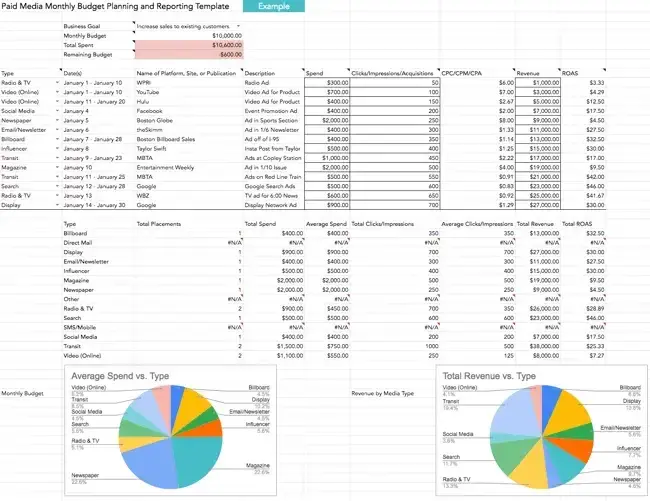
Effective media planning is crucial for any business to succeed today.
Media content — images, videos, written content, and podcasts — keeps you top-of-mind with your target audience and helps you stand out from competitors by ensuring your brand remains visible and engaging.
That’s why I always advise clients to create and share fresh media content.
However, keeping track of, planning, distributing, and analyzing all your media content can take time and effort. Effective media planning helps you manage these tasks efficiently and maintain a strong presence.
What is media planning?
Media planning is the process of determining how, when, where, and why your business shares media content with your audience. The process includes deciding what media will be shared and which channels you’ll use to boost reach, engagements, conversions, and ROI, among other metrics.
Media planning has many moving parts, making it tricky to master.
However, by following the right media planning steps and using media planning templates, you can simplify the process and tackle any challenges that come your way.
What is a media plan?
A media plan details what kind of media you’ll create and where and how you’ll publish it to best engage and convert your audience. Some media plans align with larger company initiatives and campaigns, following along with pre-approved messaging and content.
Types of Media Plans

Choosing the right type of media plan depends on your campaign goals, budget, and the nature of your product or service. But before all that, you need to understand the different types of media plans.
Continuous Media Plan
A continuous media plan involves a steady run of ads over a period. This is best for products or services that aren’t seasonal and need constant consumer reminders. Think: toothpaste or soap.
The idea is to ensure frequent exposure that keeps your brand top-of-mind all year.
Flighting Media Plan
A flighting media plan alternates periods of advertising with periods of no advertising. Consequently, this facilitates high-intensity exposure during crucial periods, creating urgency and anticipation that leads to more revenue.
Contrary to continuous media plans, it’s perfect for seasonal products or services with fluctuating demand. For example, a company selling holiday decorations might heavily advertise before the holiday season and stop afterward.
However, you need to know your brand‘s peak times. Use tools like HubSpot’s marketing analytics software to analyze sales data across multiple marketing channels and accordingly adjust your flighting periods for optimal results.
Pulsing Media Plan
A pulsing media plan combines continuous and flighting plans, maintaining a steady baseline level of advertising with periods of increased intensity.
I like this approach for two reasons: (1) it balances budget efficiency with sustained brand awareness in key markets, and (2) it’s flexible and adaptable to changing market conditions.
Seasonal Media Plan
A seasonal media plan focuses on specific times of the year when a product or service is most relevant. This type maximizes impact by aligning with peak demand periods, creating strong associations with specific seasons or events, and being budget-friendly by targeting high-relevance periods.
For example, a travel company can use seasonal media plans to promote its vacation packages. It can focus advertising efforts during winter and summer, leveraging seasonal themes and promotions to make its campaigns more appealing and relevant.
Roadblock Media Plan
A roadblock media plan places ads on multiple media channels simultaneously to maximize reach and impact. For example, when launching a new product, you can run the same ad on TV, radio, online, and social media to quickly generate buzz.
Think of it as synchronizing ads across various platforms — you create a strong, unified message that captures attention and encourages immediate response. However, this approach requires careful planning and coordination to ensure everything runs smoothly and effectively.
Drip Media Plan
A drip media plan steadily releases content or ads, just like a slow, constant drip. This approach is perfect for educational campaigns or nurturing leads over time.
For instance, in an email marketing campaign for a B2B software company, we used a drip media plan. We sent out valuable emails over several weeks, each tailored to address specific pain points and needs. This way, every touchpoint added value and brought prospects closer to a purchase decision.
The goal was to keep our audience engaged with regular, helpful content. Over time, we built relationships and trust, which ultimately led to conversions.
Benefits of Media Planning
Media planning aids with parts of content creation and distribution, including:
- Getting to know your target audience on a deeper level so you can effectively reach them through your media content.
- Deciding on which media channels and platforms you’ll share your content.
- Determining the timing and frequency of the media and content you publish and share
- Keeping up with the latest media trends and technology.
- Sticking to your budget as you work to create, publish, and share high-quality and engaging media content.
- Conducting analyses to measure the success of your media planning process.
Now that we’ve discussed the benefits of media planning, let’s review the steps in the media planning process so you can begin developing a strategy for your business.
Media Planning Process
- Conduct market research.
- State your media planning objective.
- Create your media plan using a template.
- Implement your media plan.
- Evaluate your success.
As you work through the steps in media planning, keep in mind that how your business applies the results and conclusions derived from each step will be unique based on your audience and needs.
1. Conduct market research.
The first thing I do when developing a media planning process is conduct market research. This step allows me to tailor the content and the media plan to my target audience and customers.
Start by creating and studying your buyer personas. You need to understand who your target audience and current customers are.
Then, with this information, determine what media will reach, resonate with, and convert your audience best. Additionally, select the platforms and channels you’ll use to publish and share your content.
Featured Resource: HubSpot’s Market Research Kit + Templates
2. State your media planning objective.
Next, I always keep a clear goal in mind.
This helps me navigate the process effectively and guides me in deciding which content types and platforms to focus on.
Having specific goals allows me to confidently say “no” to options that don’t align with my campaign’s objectives.
Here are some examples of media planning objectives you may have:
- Strengthen cross-team collaboration (e.g., content, graphic design, animation, video, blog, social media) while creating and sharing media.
- Enhance and streamline the publication and distribution processes for all media.
- Improve media distribution timeline to ensure our content is shared efficiently so it’s relevant to our target audience.
- Amplify the success of our media content by allowing for ample time to analyze its impact and reach our audience.
For instance, let’s say you’re planning your social media content for Facebook and Instagram. Your goal can be to streamline the content creation process and schedule your posts ahead of time.
This way, you can ensure your content is always relevant and engaging, keeping your brand top of mind.
3. Create your media plan using a template.
Now, it’s time to make your media plan.
I’ve learned that it’s not enough to simply plan and then assume everyone else is on the same page. You need to outline your strategy through a detailed media plan. When you do this, you ensure alignment within your team and keep all parties accountable.
Some media plans can also serve as standalone strategies that detail how brands plan to leverage media — written, video, audio, etc. — to connect with followers and customers.
Media planning templates are invaluable in staying efficient and effective while working on all aspects of media content. They help keep everything organized while publishing and sharing it with your audience.
Given the variety of templates available for different types and parts of the media planning process, the templates you incorporate will be unique to your business. Don’t be afraid to experiment with or combine different templates.
When one of HubSpot’s clients needed to create a media plan for Facebook and Instagram, our team implemented a social media calendar template for them.
This type of template helped coordinate content across both channels, boost engagement, and improve productivity among team members.
It ultimately helped our clients achieve their objectives faster.
4. Implement your media plan.
Ensure all parties who should be aware of the plan have the necessary details to help you execute accordingly.
When our team works on media plans, we always share the contact details of the media planning coordinator in our company so that anyone with questions or comments knows exactly who to reach out to.
To get a better understanding, let’s refer back to our example of steps for a social media plan designed for Facebook and Instagram.
When we implemented a social media calendar template as part of our client’s media plan, we made sure everyone involved, whether on the creative team or the publication team, had access to it. This way, everyone was on the same page and could contribute effectively.
5. Evaluate your success.
Whether your media plan revolves around individual posts on Instagram or a month-long, company-wide campaign, it’s crucial to measure its success.
Ask yourself and your team questions like, “How did this media plan help us achieve our specific goals? If it didn’t, why?” and “How did the media planning templates and tools we used add value to our media creation and publication processes? If they didn’t, how do we move forward?”
The way you evaluate your media plan’s success should be directly tied to the specific goals of your business regarding your media content, the teams who create the media, and the value you hope to derive from it (e.g., boosting conversions, engagements, revenue, etc.).
For instance, when reflecting on past campaigns, our team often evaluates whether our social media content plan and calendar template helped the client reach their target audience and achieve their desired objectives.
We also assess whether our media plan boosted engagement on the client’s focused social platforms, constantly seeking ways to collaborate and coordinate more effectively.
Media Planning Strategy Components
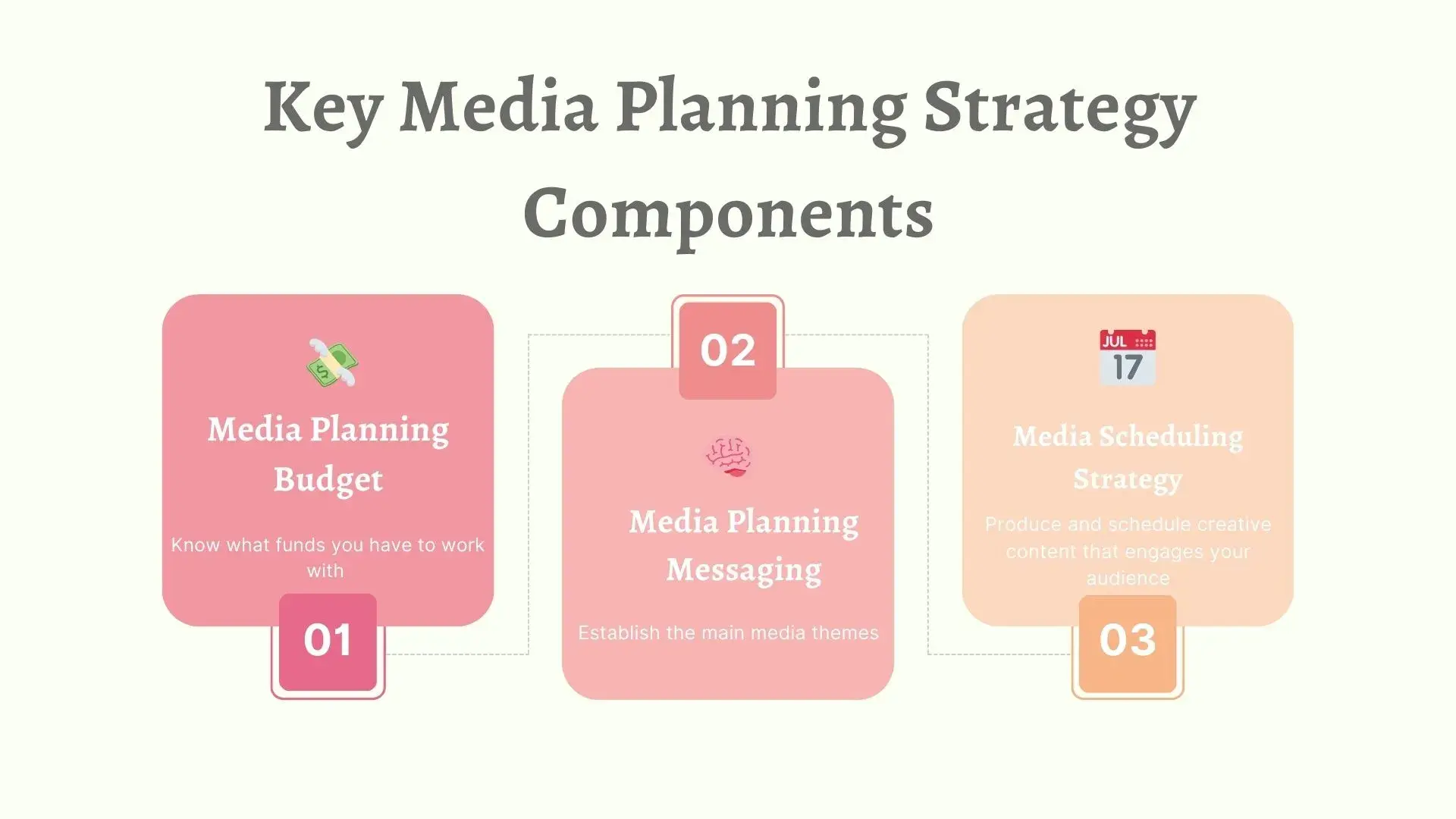
There are a few additional things to consider when crafting your media planning strategy.
First, what’s your media planning budget?
Media Planning Budget
If you’re aiming for free media, you can disregard this question. But if part of your media planning involves media buying, sit down with your marketing leadership to understand what funds you have to work with.
Set this budget before researching platforms and creating content. You don‘t want to start formulating a campaign that you can’t afford down the road.
Pro tip: Include the costs of curating and distributing media kits in your budget if you plan on expanding media coverage later. For inspiration, check out our top media kit examples cherry-picked by Ramona Sukhraj, Principal Marketing Manager at HubSpot.
Second, consider the key messaging points you want your media to communicate.
Media Planning Messaging
You don’t have to pre-write all your media content, per se, but I recommend establishing the main themes at the beginning so all media is consistent and on theme.
These messaging points should come from your audience research and will guide your content types and platforms, so nail these down first.
Third, you need the media content for publishing.
Media Scheduling Strategy
A solid media scheduling strategy lets you create content when inspiration strikes and fine-tune your advertising strategy when you’re ready. This saves you time in the long run.
Your scheduling strategy will look different based on the kind of media you’re working on.
For example, timing is everything for social media posts (free or paid ads). You need to schedule your posts based on when your target audience is online, even when that time is inconvenient for you. Thankfully, there are many tools, such as HubSpot’s social media management software, that can help with this.
On the other hand, consistency is key for newsletters and blog posts. You want your audience to be looking forward to your media content, thereby boosting traffic and fostering a community around your brand.
My top tips for your media scheduling strategy include:
- Study your readers and prospects to know when they’re available on specific platforms
- Prepare your content in bulk to avoid any inconveniences, such as delayed deadlines, which will affect your frequency
- Choose the correct automation tools for each platform
- Be consistent—consistency is everything!
With these points in mind, let’s walk through how to create a media plan of your own.
How to Create a Media Plan
1. Target your buyer personas.
As a marketer, you don’t want to advertise to just anyone. You want to attract the type of buyer who is interested in the media you’re creating—otherwise known as your buyer personas.
A buyer persona is a semi-fictional representation of your ideal customer based on market research and real data about your existing customers.
When you know exactly the type of buyer you need to target with your media plan, you can attract the most valuable customers to your business.
When making buyer personas, I often center them around these important attributes:
- Demographics: Age, income, location, or identity
- Background: Job, career path, and lifestyle
- Identifiers: Communication preferences and social media platforms
- Goals: Primary, secondary, personal and professional
- Challenges: Their roadblocks preventing them from achieving their goals
2. Define your SMART goals.
When setting goals for your media plan, use the SMART goals framework (Specific, Measurable, Attainable, Relevant, Time-Bound). This will help you track progress and achieve greater impact.
Moreover, establishing these goals before starting ensures your media plan has a clear direction for you and your team. It also means you can celebrate your successes when they happen.
Some examples of SMART goal-setting in media planning could look like:
- Specific: “We want to generate a greater number of qualified leads.”
- Measurable: “We want our media plan to gain 2,000 followers across Twitter, Metaverse, and Instagram.”
- Attainable: “We previously reached 70% in customer engagement online over the past quarter, so we’re aiming for 75% in the next.”
- Relevant: “We want to achieve more positive customer engagement to better the brand’s reputation and gain more fans.”
- Time-Bound: “We want our media plan to gain 2,000 followers in the next three months across Twitter, Metaverse, and Instagram.”
Once you’ve determined your goals, start exploring resources that can help you reach them.
3. Find the media planning tools best suited for you.
I‘ll share some fantastic media planning templates for your business later in this post, but first, let’s talk about software tools that can do some of the heavy lifting for you.
To start, HubSpot Marketing Hub is perfect for drafting, planning, scheduling, and collecting conversion analytics. But if you’re looking for more options, check out our list of 15 essential media planning tools for you to use.
4. Analyze historical data.
You have to know where you began before you can start moving forward. I always look back at my previous media planning strategies to analyze their impact and reach.
For example, if your brand is already on Facebook, I’d check the business page insights to see how far we got with the old posting schedule and content. I’d also look at the posts that got the most engagement, the time periods with the highest traffic, and the content that helped turn prospects into customers.
By noting the effective elements of your previous strategy, you can let that drive some of your brainstorming for your new media plan. Think of it as building on past successes.
5. Choose your media mix.
When it comes to choosing your media mix, it’s important to stay informed about the most popular marketing channels, as well as the ones preferred by your buyer personas.
According to HubSpot’s State of Marketing Report, over 1,400 global marketing professionals believe the marketing channels with the highest ROI are:
- Websites/Blogs
- Social Media
- Email Marketing
- Content Marketing
In my experience, an omnichannel media plan works great to reach your target audience wherever they are. By researching which channels your buyer personas frequent the most and being open to exploring new ones, you can decide on the right mix for your brand.
6. Put your media plan into action.
When working on your media plan, keep an eye on your insights and see how they stack up against your SMART goals. Remember, you can always adjust your plan as needed. Marketing is a dynamic field, and being able to pivot is crucial.
Now that you‘re familiar with creating a plan, let’s look at some resources to make the media planning process easier.
Media Planning Templates
There are plenty of media planning templates available online, both for purchase and for free. What I love about using these templates is how customizable they are; you can tailor them to fit your business’s specific needs and goals.
Depending on the media software your business uses, such as HubSpot’s (free) CRM, Marketing Hub, or Sprout Social, there may already be customizable planning templates included. I’ve often used HubSpot’s templates, which offer a great menu of options to choose from.
Of course, you can also create your own templates using Google Sheets. I’ve done this myself, and it’s a great way to ensure your planning process fits perfectly with your unique workflow.
Whatever method you choose, remember that your media planning templates should evolve as your goals and audience grow. Don’t hesitate to adjust them over time to stay in sync with your business’s changing needs.
Free Media Planning Template [Download Now]
Types of Media Planning Templates
Here’s a list of common media creation and planning templates to get you started. (Click the links to access each template.)
Choose the templates that suit your needs. Remember, there‘s no right or wrong choice—it’s all about what works best for your business.
- Use a media planning template to organize your paid media efforts and expenses in one visual location.
- Use a social media strategy template to align your media content with your audience in a way that provides value for your business.
- Use a social media calendar template to customize a timeline for when you’ll share your social media posts in a simple, organized, manageable, and effective format.
- Use an editorial calendar template to plan and optimize all the marketing content you’ll publish and share, including blogs, social media posts, and campaigns.
- Use a blog post template to simply fill in the blanks and begin writing engaging, relevant, and well-optimized blog content for your audience (all while avoiding writer’s block!).
- Use an ebook design template to take the guesswork out of how to make your ebook professional, eye-catching, and beautiful, all while saving yourself valuable time.
- Use an infographic template in PowerPoint or Illustrator to quickly customize the way you present data, share insights, and promote offers in a way that looks and feels professional.
- Use an analytics and reporting template for Excel, PowerPoint, and Google Drive to make the processes of pulling, organizing, and sharing data simple no matter which metrics you track.
- Use a budget template to manage and review your spending and budget with Excel or Google Sheets.
- Use an advertising template to help you plan and manage advertising campaigns in a way that’s sure to convert audience members into leads and customers.
Media Plan Examples
Although we’ve discussed media planning and even shared a few media planning templates, doing it practically may still pose a challenge. Therefore, I’ve created media plan examples and linked the templates I used for more clarity.
Social Media Plan
When it comes to social media, focus your efforts on the platform where your customers are active. If you’re still figuring that out, it’s fine to experiment with a few platforms to see what works best.
Here’s a sample social media plan inspired by HubSpot’s Social Media Content Template to help you explore multiple platforms.
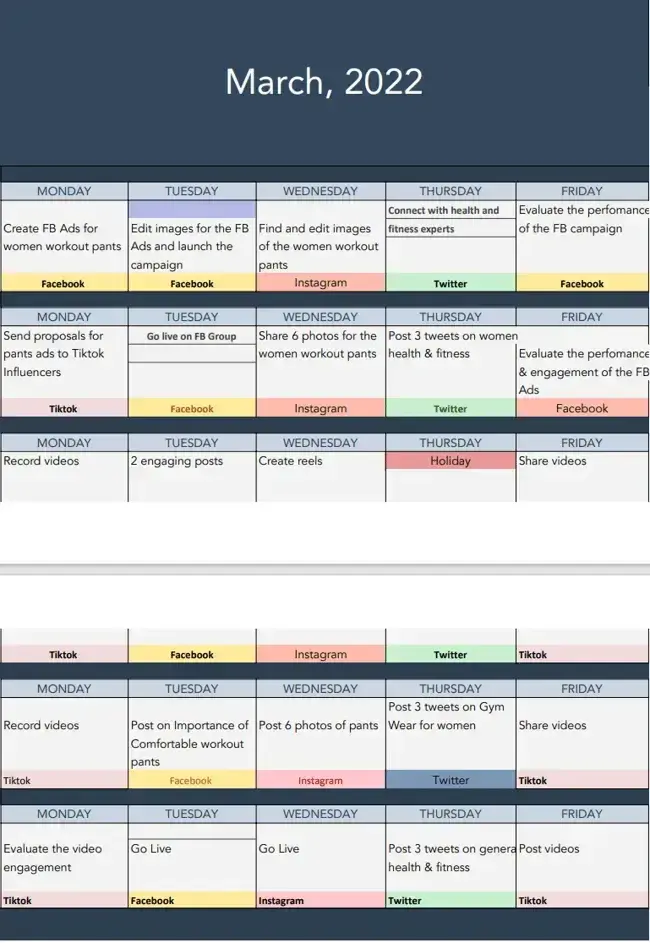
Blogging Media Plan
Tracking how often you publish blog content is crucial for monitoring your progress. A blogging media plan can help you manage your writers efficiently, reducing the need for constant email follow-ups about their blog post progress.
Here is a simple example of a blogging media plan you can download from HubSpot.
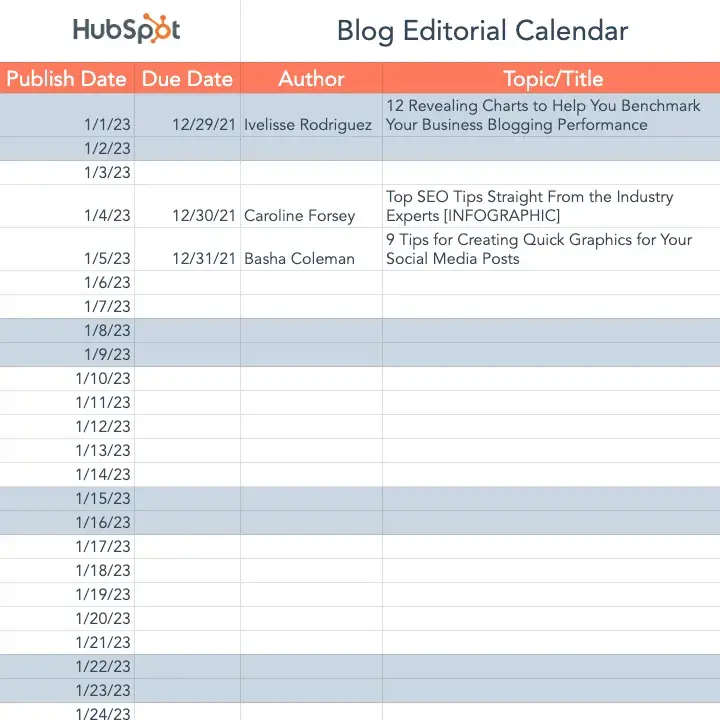
PR Media Plan
Creating a PR media plan can be a bit more intensive since it involves coordinating with other organizations. You’ll need to choose the right form of advertisement, gather the necessary resources, and identify key contacts.
In this sample template, I’m only sharing the “reach out” and “content planning” phases. However, the complete template from HubSpot has everything you need, including resource planning. As a bonus, if you’re a beginner, you can even take the free course on PR Media. Check out the complete HubSpot PR Plan template.
|
Activity |
Description |
Start Date |
End Date |
|
Guest posts |
Promoting our new workout pants |
3 March, 2025 |
3 June, 2025 |
|
Press releases in known publications |
Promoting our brand in general |
10 July, 2025 |
20 December, 2025 |
|
Newsletters |
Send out monthly newsletters every month |
3 March, 2025 |
29 December, 2025 |
We‘ve covered media planning in detail, but there’s another crucial aspect to consider: media buying.
Let’s get into it.
Media Planning vs. Media Buying
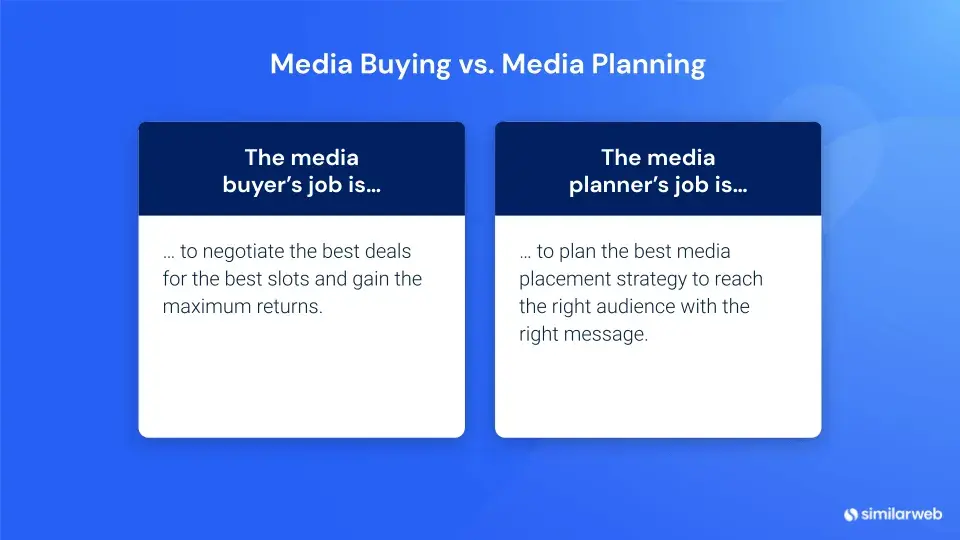
Digital media planning and media buying are closely related and work hand-in-hand. Depending on your business size and budget, the same team members might handle both planning and buying.
So, what makes these processes unique?
Media planning involves deciding which media content to create, publish, and share with your customers and target audience. This media content is all-encompassing and doesn’t always include paid ads and content.
Media buying, on the other hand, is a distinct process focused on purchasing advertising space and time on various platforms. This is where the main difference between media planning and media buying lies.
What is media buying?
Media buying is all about paid media. This means your business buys campaigns or ad space on various channels, pays to share targeted campaigns and ads, or negotiates with media vendors.
While sharing media and reaching your audience for free is possible, effective media planning can still happen without media buying. However, media buying always requires media planning.
Think of it like this: all squares are rectangles, but not all rectangles are squares. Media planning sets the tone and direction for the media buying that follows.
Once you’ve purchased ad space or negotiated content distribution, you need a strategy—or a media plan—for delivering that media to your audience and customers.
Media Planner
A media planner is also known as a brand strategist or a brand planner. They’re responsible for planning advertising strategies and creating campaigns for businesses.
If you don’t have an in-house media planner, you’ll need to consider hiring one to help you with the campaigns. But what exactly does a media planner do? And how much will it cost?
Below are the answers.
What does a media planner do?
A media planner takes over your whole media planning strategy, evaluates it, and advises you on the way forward.
Here are some roles that a media planner will handle in your company:
- Maximizing the impact on all advertisements you pay by networking with media buying agencies
- Coming up with creative ways to reach out to your target audiences for better engagement and conversion rates
- Identifying the best platforms for your business to ensure you’re spending your ad money where you’re likely to get returns
How much do media planners make?
According to Comparably, the average Media Planner in the US makes $69,374. When working with a media planner, expect to pay them between $30,000-$150,000.
If you need an expert planner with many years of experience, then you’ll need to plan for about $155,000.
However, you can always save money by hiring a freelance media planner. They might charge a bit more per hour, but you only pay them when you have a project.
Begin Your Media Planning Process
Media planning is an integral part of your business’s ability to create, publish, and share media content successfully.
I recommend employing the pulsing media plan where you can. It gives you the consistency of continuous advertising with the intensity of flighting, ensuring a steady presence while allowing for strategic bursts of activity.
What has always surprised me is how dynamic media planning can be. No two campaigns are the same and require their own unique strategy, but that‘s part of the challenge and excitement. As long as you know when and where to engage your audience, you’re on the right path.
Editor’s note: This post was originally published in February 2020 and has been updated for comprehensiveness.

